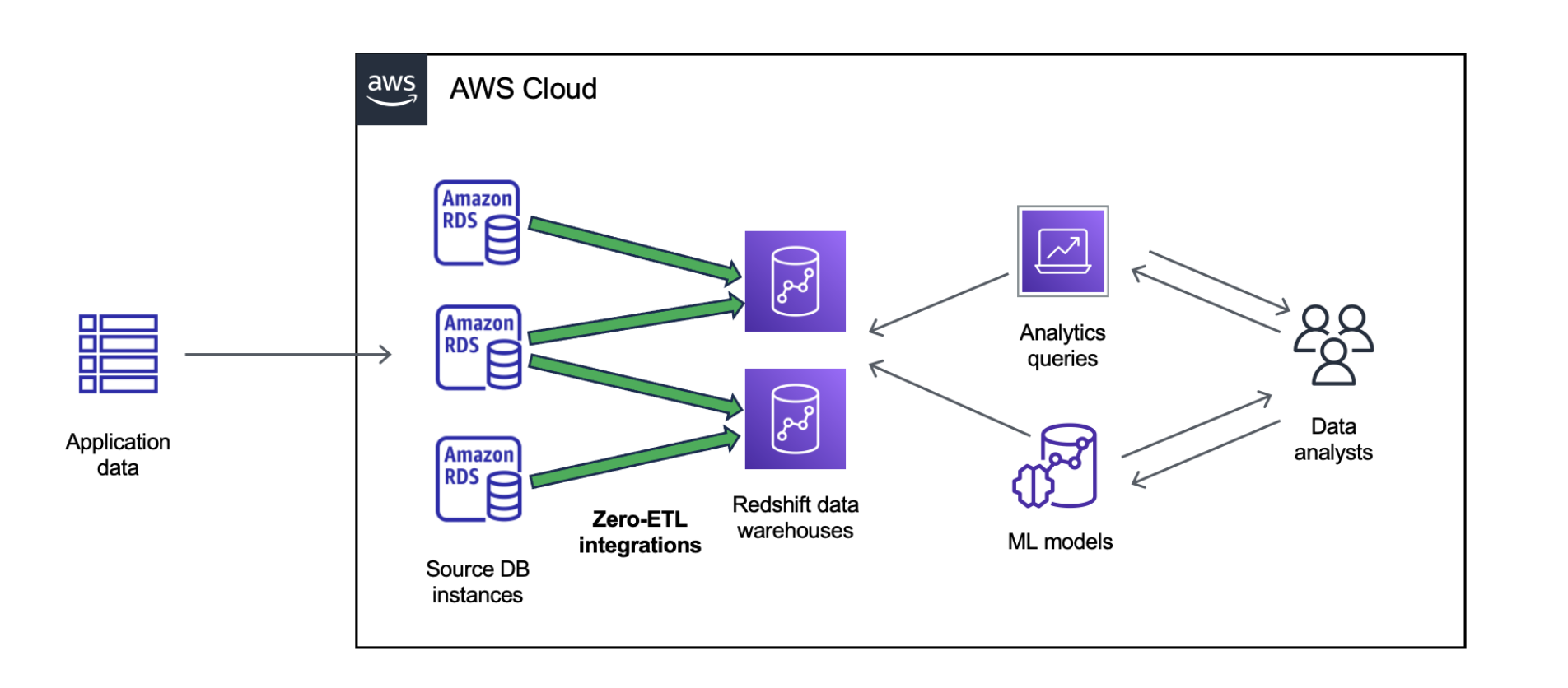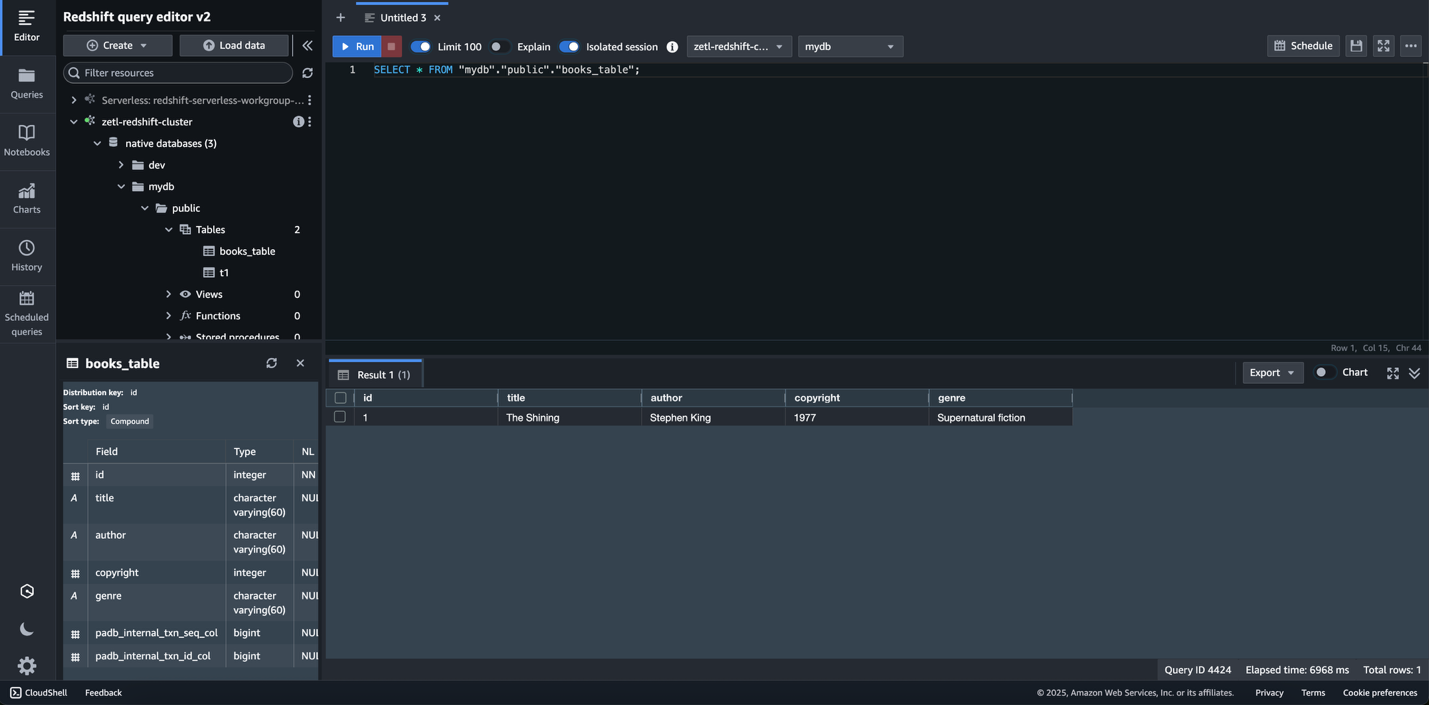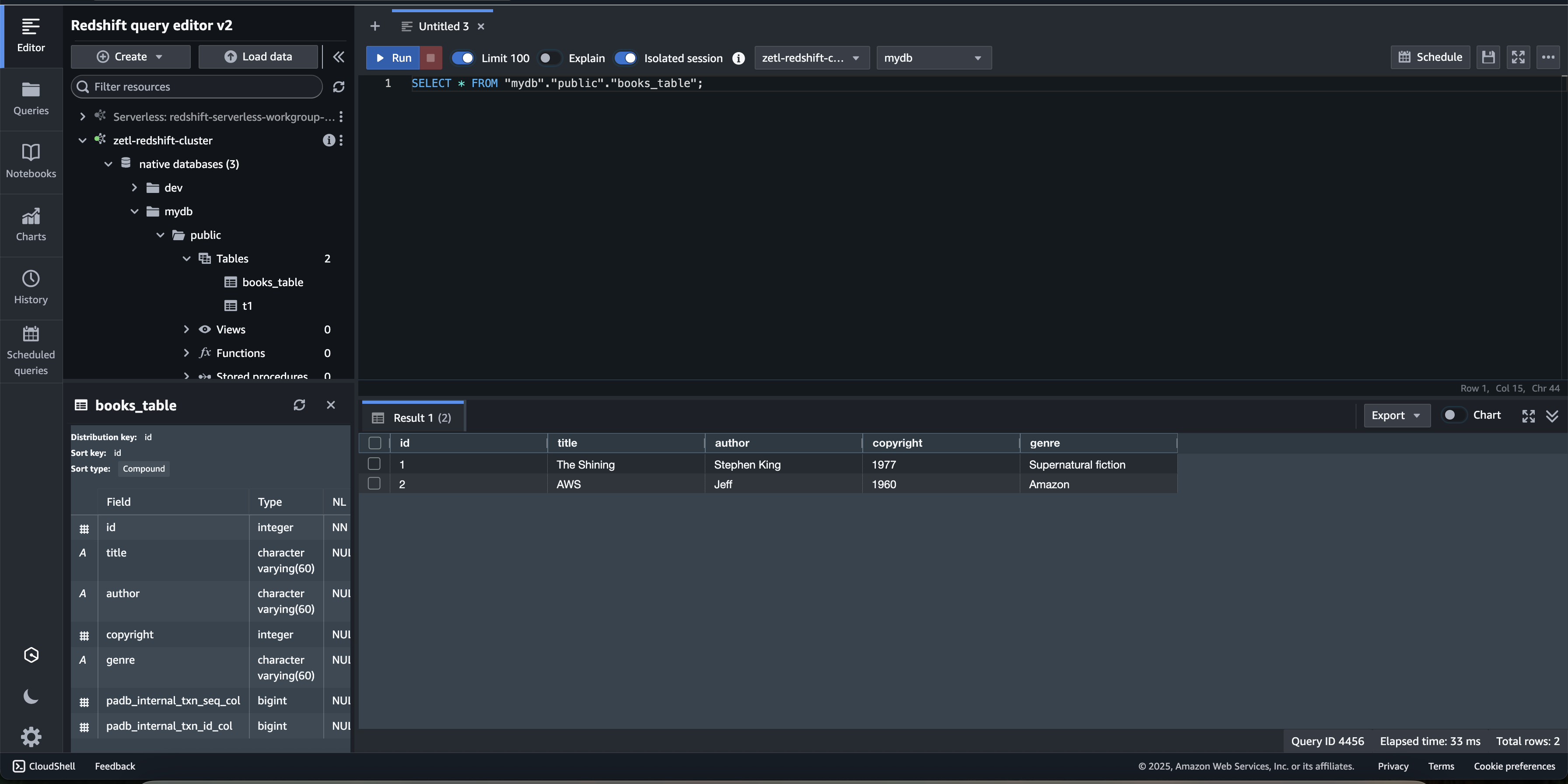Zero-Latency Data Analytics for Modern PostgreSQL Applications
Learn in this article how to set up Amazon RDS for PostgreSQL zero-ETL integration with Amazon Redshift for near-real-time analytics using the AWS CLI.
Join the DZone community and get the full member experience.
Join For FreeOn July 23, 2025, AWS announced Amazon Relational Database Service (Amazon RDS) for PostgreSQL zero-ETL integration with Amazon Redshift, enabling near real-time analytics and machine learning (ML) on petabytes of transactional data. With this launch, you can create multiple zero-ETL integrations from a single Amazon RDS PostgreSQL database, and you can apply data filtering for each integration to include or exclude specific databases and tables, tailoring replication to your needs. You can also use AWS CloudFormation to automate the configuration and deployment of resources needed for zero-ETL integration.
Zero-ETL integrations make it simpler to analyze data from Amazon RDS to Amazon Redshift by removing the need for you to build and manage complex data pipelines and helping you derive holistic insights across many applications. Within seconds of data being written to Amazon RDS for PostgreSQL, the data is replicated to Amazon Redshift. Using zero-ETL, you can enhance data analysis on near-real-time data with the rich analytics capabilities of Amazon Redshift, including integrated ML, Spark support, and materialized views.

Prerequisites
You must have the following prerequisites:
- The AWS Command Line Interface (AWS CLI) v2 installed and configured with appropriate credentials.
- Sufficient AWS identify and access management (AWS IAM) permissions to create and configure Amazon RDS. For more details, refer to Creating an Amazon RDS DB instance.
- An RDS for PostgreSQL (source) DB instance set up and accessible on its respective SQL port. For this post, we use RDS DB instances with PostgreSQL version 15.7 and later.
- An Amazon Elastic Compute Cloud (Amazon EC2) Security group set up and allowing a DB instance port connection to the source and target DB instances.
Implementation
Create a Custom Amazon RDS DB Parameter Group
Use the following code to create a custom RDS DB parameter group:
aws rds create-db-parameter-group \
--db-parameter-group-name zetl-pg-parameter-group \
--db-parameter-group-family postgres15 \
--description "zetl parameter group for postgresql" \
--region us-east-1Modify the rds.logical_replication, rds.replica_identity_full, session_replication_role, wal_sender_timeout, max_wal_senders, max_replication_slots parameters to set their new values. See Zero-ETL documentation about these parameters.
aws rds modify-db-parameter-group \
--db-parameter-group-name zetl-pg-parameter-group \
--region us-east-1 \
--parameters "ParameterName=rds.logical_replication,ParameterValue=1,ApplyMethod=pending-reboot" \
"ParameterName=rds.replica_identity_full,ParameterValue=1,ApplyMethod=immediate" \
"ParameterName=session_replication_role,ParameterValue=origin,ApplyMethod=immediate" \
"ParameterName=wal_sender_timeout,ParameterValue=0,ApplyMethod=immediate" \
"ParameterName=max_wal_senders,ParameterValue=20,ApplyMethod=immediate" \
"ParameterName=max_replication_slots,ParameterValue=20,ApplyMethod=immediate"Select or Create a Source Amazon RDS PostgreSQL Database
If you already have an RDS instance, you can use that, or you can create a new instance with the following code:
aws rds create-db-instance \
--db-name zetldb \
--engine postgres \
--engine-version 15.7 \
--db-instance-class db.r5.large \
--master-username test \
--master-user-password ****** \
--db-parameter-group-name zetl-pg-parameter-group \
--allocated-storage 10 \
--db-instance-identifier zetl-pg-db \
--region us-east-1Wait for your RDS instance to be in available status. You can make a describe-db-instances API call to verify the DB instance status:
aws rds describe-db-instances --filters 'Name=db-instance-id,Values=zetl-pg-db' | grep DBInstanceStatusLoad Data in the Source RDS Database
Connect to the source PostgreSQL database and run the following commands:
psql -h zetl-pg-db.************.us-east-1.rds.amazonaws.com -d zetldb -U test -p 5432 -W
zetldb=> CREATE TABLE books_table (ID int primary key, Title VARCHAR(50), Author VARCHAR(50),Copyright int, Genre VARCHAR(50));
zetldb=> INSERT INTO books_table VALUES (1, 'The Shining', 'Stephen King', 1977, 'Supernatural fiction');
zetldb=> commit;This data will be our historic data. After we create an integration, we will generate new live data.
Create a Subnet Group for the Redshift Cluster
Use the following code to create a cluster subnet group:
aws redshift create-cluster-subnet-group \
--cluster-subnet-group-name zetl-subnet-group \
--subnet-ids "subnet-d0437eef" "subnet-*****" "subnet-*****" "subnet-*****" "subnet-*****" \
--description "subnet group for redshift" \
--region us-east-1Create a Custom Parameter Group for the Amazon Redshift Cluster
Use the following code to create a custom parameter group for the Redshift cluster:
aws redshift create-cluster-parameter-group \
--parameter-group-name zetl-redshift-parameter-group \
--parameter-group-family redshift-1.0 \
--description "cluster parameter group for zetl" \
--region us-east-1Modify the enable_case_sensitive_identifier parameter and set its value to ON. This is required to support the case sensitivity of source tables and columns. The enable_case_sensitive_identifier parameter is a configuration value that determines whether name identifiers of databases, tables, and columns are case sensitive. This parameter must be turned on to create zero-ETL integrations in the data warehouse.
aws redshift modify-cluster-parameter-group \
--parameter-group-name zetl-redshift-parameter-group \
--parameters ParameterName=enable_case_sensitive_identifier,ParameterValue=ON \
--region us-east-1Select or Create the Target Redshift Cluster
If you already have a Redshift cluster, you can use that, or you can create a new cluster with the following code:
aws redshift create-cluster \
--cluster-identifier zetl-redshift-cluster \
--cluster-parameter-group-name zetl-redshift-parameter-group \
--port 5439 \
--master-username test \
--master-user-password *****\
--node-type ra3.xlplus \
--number-of-nodes 2 \
--maintenance-track CURRENT \
--cluster-subnet-group-name zetl-subnet-group \
--region us-east-1Wait for your cluster to be available; you can make a describe-clusters API call to verify cluster status:
aws redshift describe-clusters --query 'Clusters[?ClusterIdentifier==`zetl-redshift-cluster`]' | grep ClusterStatusConfigure Authorization Using an Amazon Redshift Resource Policy
You can use the Amazon Redshift API operations to configure resource policies that work with zero-ETL integrations.
To control the source that can create an inbound integration into the Amazon Redshift namespace, create a resource policy and attach it to the namespace. With the resource policy, you can specify the source that has access to the integration. The resource policy is attached to the namespace of your target data warehouse to allow the source to create an inbound integration to replicate live data from the source into Amazon Redshift.
aws redshift put-resource-policy \
--resource-arn arn:aws:redshift:us-east-1:123456789012:namespace:fb5d655c-e169-44f4-99f6-7c501e1ca38e \
--policy "{ \"Version\": \"2012-10-17\", \"Statement\": \
[ { \"Effect\": \"Allow\",\"Principal\": { \"Service\": \
\"redshift.amazonaws.com\" } , \"Action\": [ \
\"redshift:AuthorizeInboundIntegration\"], \
\"Condition\":{\"StringEquals\":{\"aws:SourceArn\":\"arn:aws:rds:us-east-1:123456789012:db:zetl-pg-db\"}} },\
{\"Effect\":\"Allow\", \"Principal\":{\"AWS\":\"123456789012\"}, \
\"Action\":[\"redshift:CreateInboundIntegration\"] }] }" \
--region us-east-1Create a Zero-ETL Integration
In this step, we create an Amazon RDS zero-ETL integration with Amazon Redshift where we specify the source RDS for the PostgreSQL database and the target Redshift data warehouse. You can optionally also provide data filters, an AWS Key Management Service (AWS KMS) key that you want to use for encryption, tags, and other configurations.
aws rds create-integration \
--source-arn arn:aws:rds:us-east-1:123456789012:db:zetl-pg-db \
--target-arn arn:aws:redshift:us-east-1:123456789012:namespace:fb5d655c-e169-44f4-99f6-7c501e1ca38e \
--integration-name zetl-test-integration \
--data-filter "include: zetldb.*.*" \
--region us-east-1Monitor the Integration
Make a describe API call to verify the integration is in active status:
aws rds describe-integrations | grep StatusVerify the Solution
To verify the solution, create a database in Amazon Redshift and connect to it. For instructions, see Creating destination databases in Amazon Redshift.
Verify the historic data in Amazon Redshift:

Next, add some new live data on the source database:
zetldb=> INSERT INTO books_table VALUES (2, 'AWS', 'Jeff', 1960, 'Amazon');Verify the new changes on the source replicated on the target within seconds.

You have successfully configured a zero-ETL integration, and new changes on the source will be replicated to the target. However, there are a few limitations that apply to RDS zero-ETL integrations with Amazon Redshift.
Clean Up
You can clean up after verification is complete:
aws rds delete-integration --integration-identifier arn:aws:rds:us-east-1:123456789012:integration:5bc7602f-61e1-4342-bfae-a69b316e3cfeTo delete the Redshift cluster without taking a final snapshot, use the following code:
aws redshift delete-cluster --cluster-identifier zetl-redshift-cluster --skip-final-cluster-snapshotTo delete the RDS DB instance without taking the final snapshot, you can run the following code:
aws rds delete-db-instance --db-instance-identifier zetl-db --skip-final-snapshot
Conclusion
In this post, we showed how you can run a zero-ETL integration from Amazon RDS for PostgreSQL to Amazon Redshift using the AWS CLI. This minimizes the need to maintain complex data pipelines and enables near-real-time analytics on transactional and operational data. With zero-ETL integrations, you can focus more on deriving value from your data and less on managing data movement.
As next steps, consider exploring how you can apply this zero-ETL approach to other data sources in your organization. You might also want to investigate how to combine zero-ETL with the advanced analytics capabilities of Amazon Redshift, such as ML integration or federated queries. To learn more about zero-ETL integrations and start implementing them in your own environment, refer to the zero-ETL documentation and begin simplifying your data integration today.
Opinions expressed by DZone contributors are their own.

Comments